Fermented Whipping Cream Crafted from Soymilk Ama-Koji
Apr 24,2025
Fermented Whipping Cream Crafted from Soymilk Ama-Koji
Apr 24,2025


There’s a fermented whipping cream harnessing the power of rice malt that’s truly a standout in every way. It’s gentle on the body. It has a nicely balanced flavor: rich on the tongue yet with a refreshing aftertaste. And it can be made in a batch to use later.
It’s a fermented whipping cream made with soymilk ama-koji (sweet rice malt). Here we talk with its inventor: fermented food and dietary therapy expert Koike Kaoru, winner of the grand prize in the Fermentation category of the 2023 Gourmand World Cookbook Awards. She tells us why this whipping cream is so wonderful and how to make it. We also ask her about her cooking classes, where she shares her many meal ideas featuring fermented foods.
Kaoru started studying macrobiotics after being seriously injured in a road accident. She offers ideas for staying healthy with an easy-to-follow dietary therapy program she developed herself, while incorporating fermented foods and brown rice into your meals. Her book Koji Fermented Cream and Fermented Snacks features recipes for confections that are gentle on the body and a feast for the eyes.
“My mother was good at making confections, and thanks to her, I love making them too. I often made snacks for my five kids, who are now all grown up. As I came to realize the advantages of using fermented food in cooking, I became interested in harnessing the benefits of koji rice malt in my confections. Koji has a mildly sweet taste, and it’s good for your health and your looks.”
Kaoru’s goal is to create guilt-free confections that everyone can enjoy whether they have allergies or not. “This cream uses no animal ingredients. It coaxes out the natural sweetness with rice koji. It’s also an easily absorbed source of soy isoflavones from soymilk, which are believed to promote beautiful skin. People of all stripes should be able to enjoy confections more, whether they’re vegan or suffer from allergies or are trying to diet.”

The amazing thing about this fermented whipping cream is that it’s every bit as rich and thick as cream made with animal fat. The source of its full, rich flavor is soymilk ama-koji.
“The enzymes produced by the koji mold break down the starch contained in the rice and soymilk into glucose and the proteins into amino acids. This process results in a sweet, delicious taste and milky flavor. And because the nutrients are broken down, they’re easier to digest and absorb, which is gentler on the body.”
Soymilk ama-koji can’t just be used to make fermented whipping cream. It’s worth trying as is, says Kaoru. “Mix it with soymilk, add lemon or cocoa powder, or put it on corn flakes or yogurt. It tastes delicious.”

The two products Kaoru regularly uses to make soymilk ama-koji. “Aeon’s Organic Unhomogenized Soymilk (left) has just the right smooth consistency. Nannichi Miso Shoyu’s Fresh Handcrafted Koji (right) has an intensely rich, sweet flavor, resulting in a nice milky taste.”
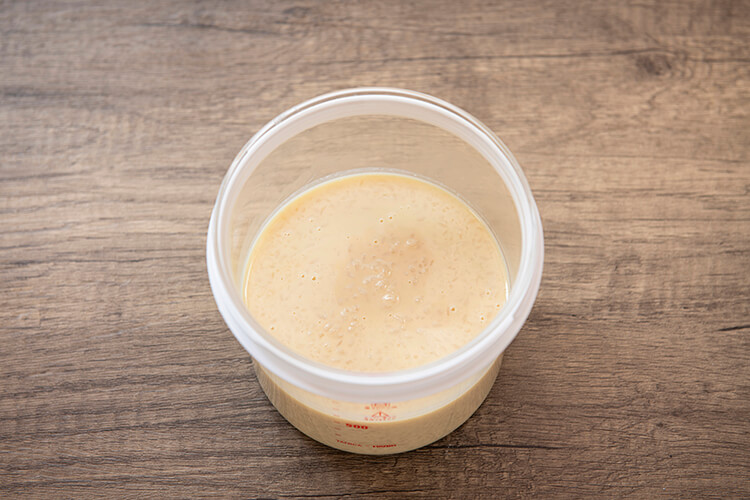
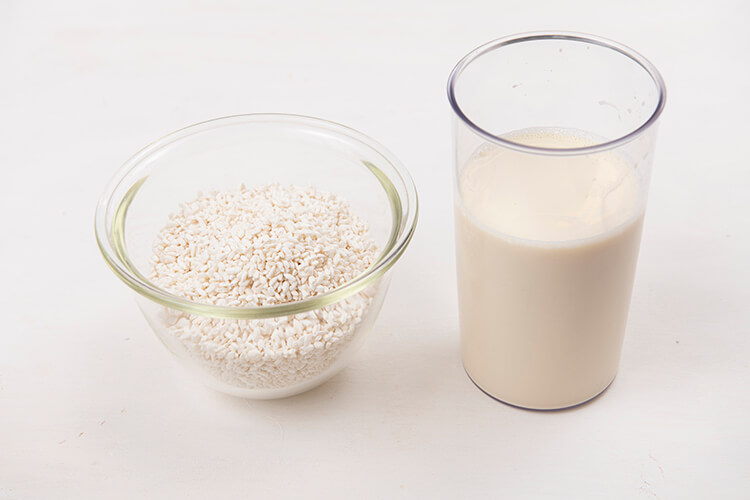
This recipe yields approx. 900 g. Use 270 g of koji if it’s dried.
1.Place the soymilk in a pan and heat over low heat to 60˚C. Turn off the heat and add the rice koji.
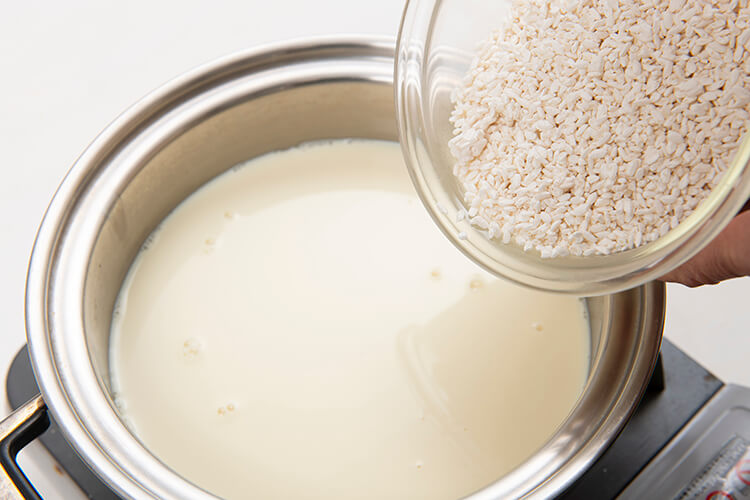
Small bubbles appearing in the soymilk indicate it’s reached 60˚C or thereabouts. Turn off the heat and promptly add the rice koji.
2.Place in a heat-resistant ziplock bag.

Placing the bag over a storage container makes it easier to pour in the contents.
3.Wrap the entire bag in a towel and place in the rice cooker. With the lid open, set to “Keep Warm” mode and let sit for six to eight hours while maintaining the temperature at around 60˚C. Remove two or three times part way through and mix by massaging the bag.
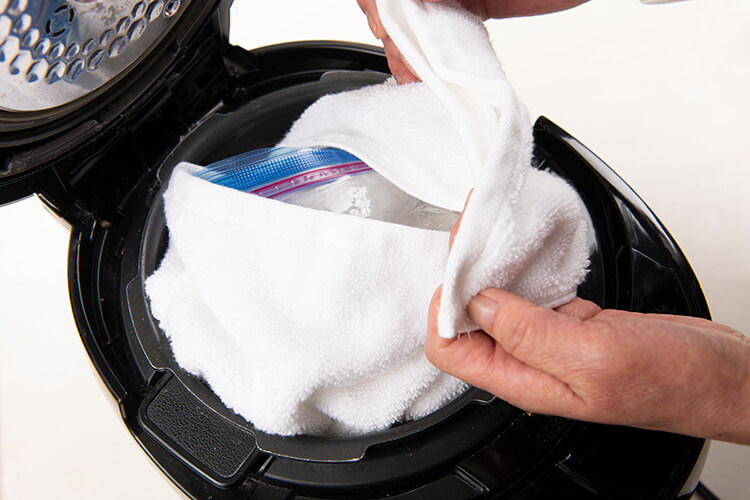
Completely wrap the bag in a towel so it doesn’t come into direct contact with the bottom of the rice cooker. Leave the lid open so the temperature doesn’t get too hot. “When the rice cooker is initially set to ‘Keep Warm’ mode, check with a thermometer that it’s around 60˚.”
NOTE: If using a yogurt maker or slow cooker, keep at a temperature of 60˚C for six to eight hours. Mix two to three times partway through.
4.Empty the bag into a pan and, once the mixture comes to a boil, turn off the heat. Let cool slightly, then transfer to a clean storage container. The cream will keep in the fridge for one to two weeks.

Soymilk ama-koji assumes a sour taste if it continues fermenting, so be sure to heat it through. It’s important to kill the lactic acid bacteria and other microorganisms and halt the action of the enzymes. Soymilk ama-koji keeps in the fridge for one to two weeks or in the freezer for a month.
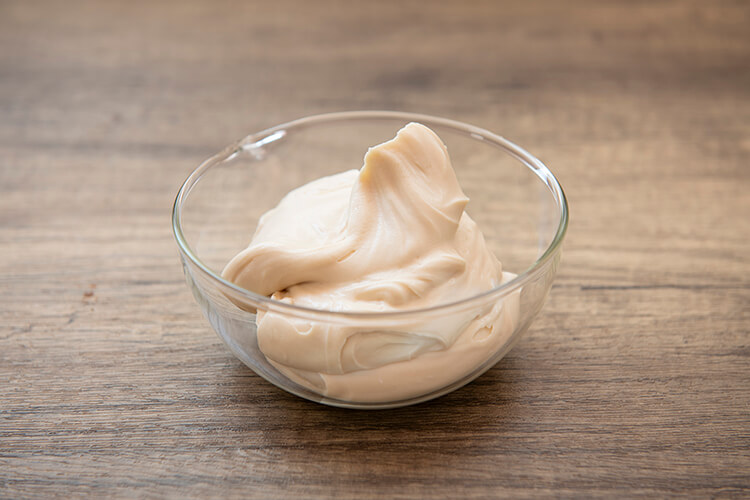
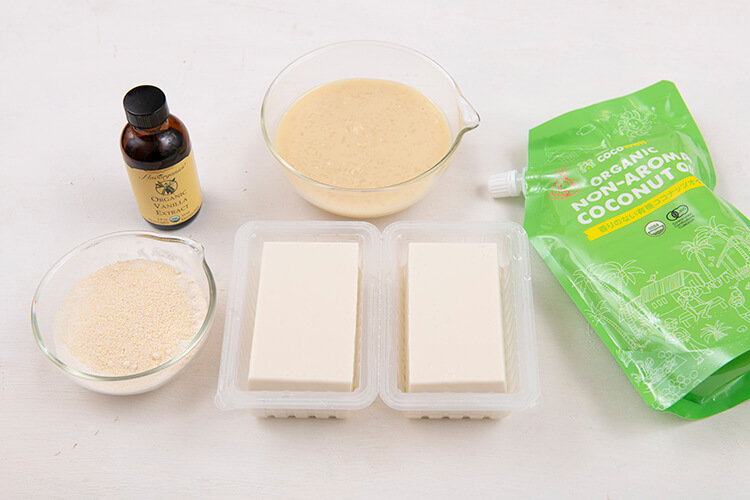
“A pre-cut block of tofu drains faster and better. I also recommend using an aroma-free coconut oil — one that doesn’t smell of coconut. For aroma, use vanilla extract with no artificial flavoring.”
Wrap the tofu in kitchen roll and place a weight on top. Let drain overnight in the fridge until it weighs 190–210 g.
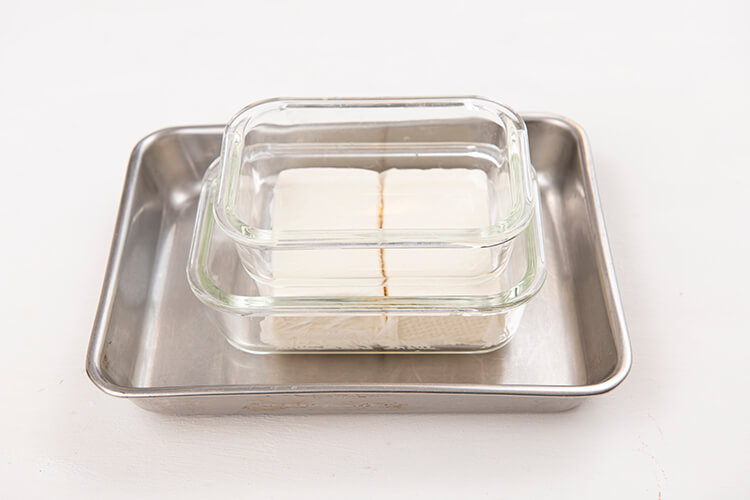
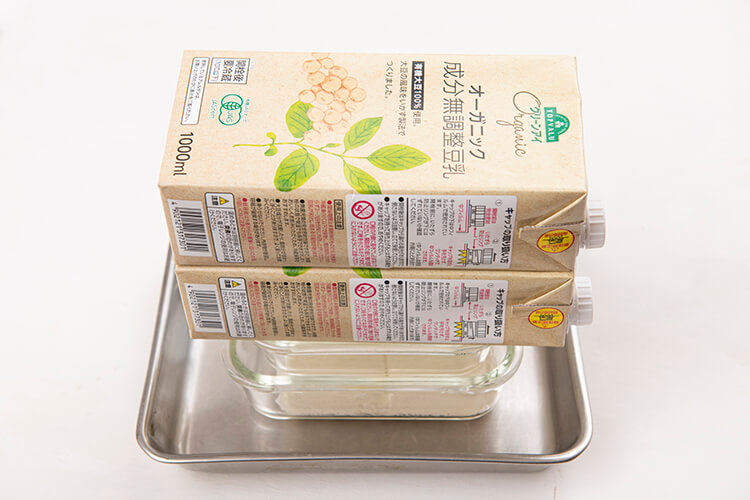
“Place two one-liter cartons of soymilk on top of the tofu to weigh it down, then let it drain overnight. If it still weighs more than 190–210 g, use something heavier and continue draining until it’s the right weight.” Wrap the tofu in kitchen roll and place it in a container, then place the container in a tray to catch the water. Put an empty container a size smaller on top (left), then pile the two cartons on it (right).
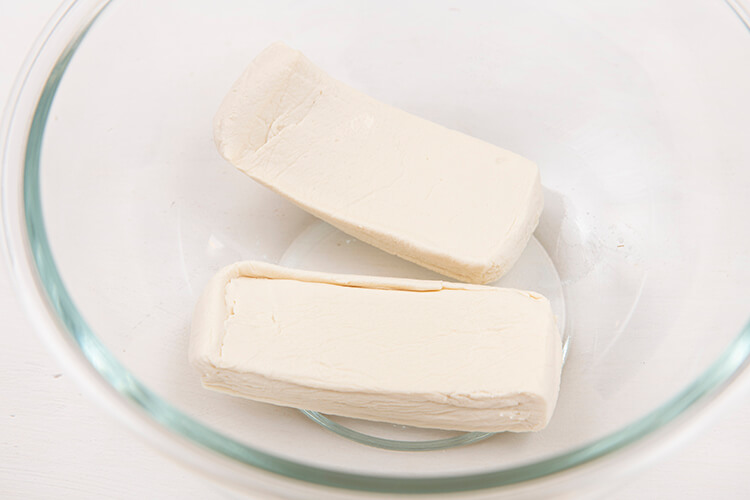
The tofu after being drained so it weighs 190–210 g. Be careful to drain it properly; otherwise the cream will turn out watery.
1.Put the tofu and other ingredients in a bowl. Place in a 40–50˚C water bath and blend with a hand blender.
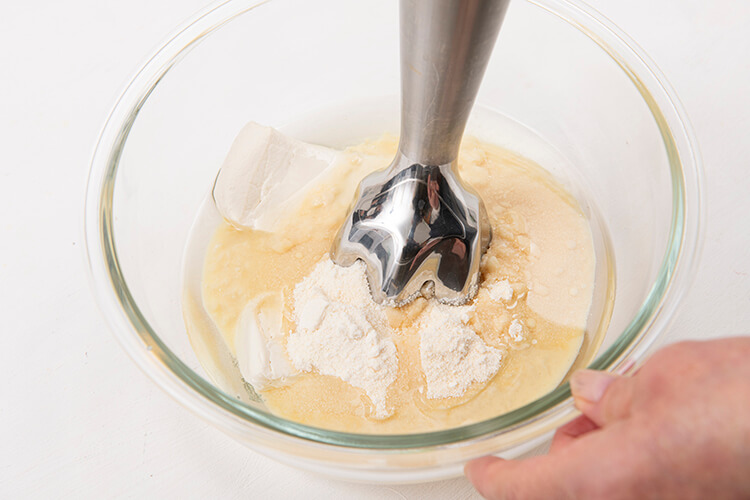

Coconut oil begins to solidify at a temperature of below 20˚C. Using a water bath when blending ensures a smooth consistency (right).
2.Once the mixture emulsifies and becomes glossy, add the vanilla extract and mix in well.
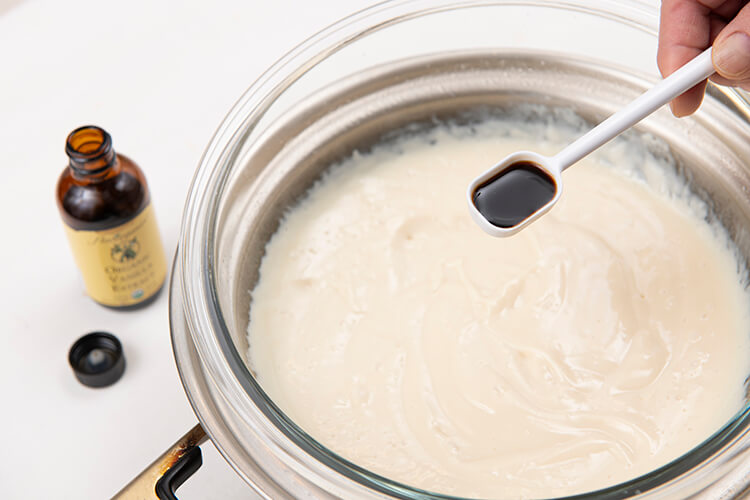
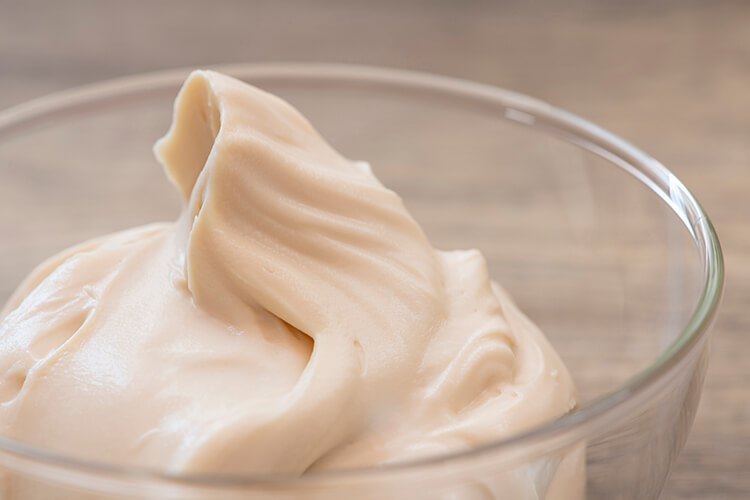
If chilled in the fridge for an extra day, the flavors will blend together better and the cream form firm peaks. It keeps in the fridge for two to three days or in the freezer for about a month.
“Not only does this cream make a nice decoration for cakes. Simply add it to some fruits of the season, and you have a nice satisfying dessert,” says Kaoru. She also shares another simple way to serve it.
“You can freeze this fermented whipping cream to make ice cream. Sandwich it between cookies and chill it in the freezer, and once it hardens, you have ice cream sandwich cookies. They look adorable and make a nice treat to serve guests. Mix matcha or cocoa powder or raspberries or whatever into the fermented whipping cream, and you can enjoy the flavor of your choice.”
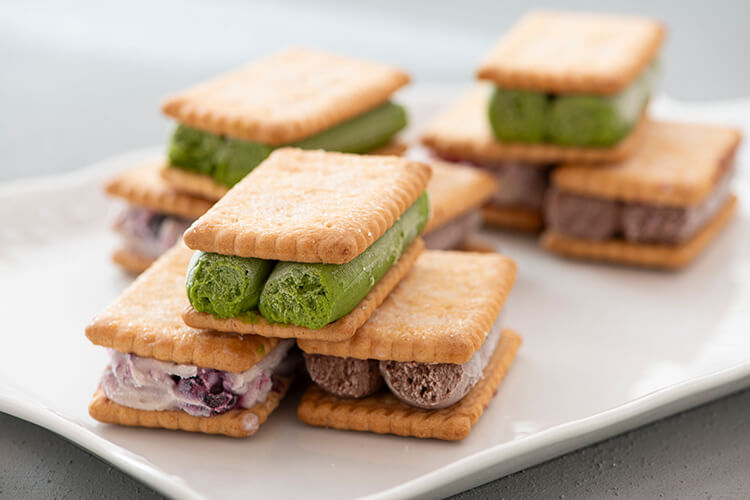
Put some fermented whipping cream in a pastry bag and dispense it on store-bought biscuits. Then place a second biscuit on top of each. Wrap in plastic wrap and keep in the freezer for at least two hours until cold and hard. As a rule of thumb, use 1.5 tsp. of matcha or 2 tsp. of cocoa powder per 100 g of fermented whipping cream.
Kaoru makes a wide spectrum of fermented foods herself. These include variations on koji like tomato koji and lemon koji, which she often uses as seasonings. Surprisingly, though, she uses store-bought salted koji and soy sauce koji for her cooking classes and when creating recipes.
“When people make salted koji or soy sauce koji at home, it tastes completely different depending on the koji and salt or soy sauce they use. Using store-bought products is essential to ensuring that a recipe tastes the same no matter who makes it. Marukome’s Plus Koji Nama Shio Koji salted koji and Plus Koji Nama Shoyu Koji soy sauce koji have a mild taste that goes nicely with any dish, whether Japanese, Western, or Chinese. They’re all you need to define the flavor; no need for flavor enhancers. That makes them extremely handy when creating a recipe. If you’re looking for an easy way to incorporate fermented foods into your cooking, then store-bought is the way to go.”
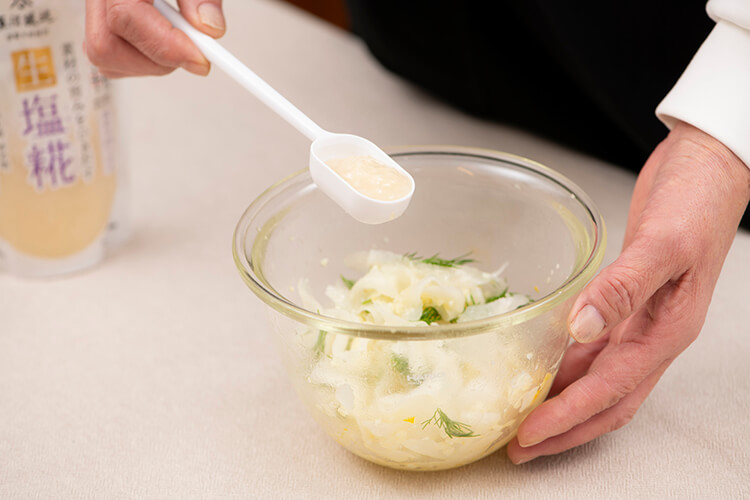
“Salted koji tastes delicious even when it’s just mixed with vegetables.” Kaoru prepared us some marinated daikon by shaving daikon into strips with a peeler, massaging it in salt, wringing out the moisture, then dressing it with dill, lemon koji, store-bought salted koji, and olive oil.

Fermented food and dietary therapy expert
Fermented food and dietary therapy expert
Koike Kaoru runs the therapeutic cooking school La cuisine d’ange. She shares recipes that nurture body and soul with her own dietary therapy-based method incorporating fermented foods. She serves as advisor to the Japanese cooking school site My Kitchen. Her book Koji Fermented Cream and Fermented Snacks: Gluten-free Recipes That Use No Dairy or Eggs (published by Asahiya Publishing) won the grand prize in the Fermentation category of the 2023 Gourmand World Cookbook Awards.